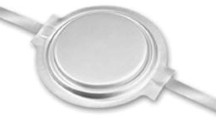Abstract
The effect of current magnitude and drug concentration on transdermal iontophoretic delivery of octreotide acetate (Sandostatin®) was examined in the rabbit. Plasma samples were collected over 24 hours and octreotide concentrations were determined by a radioimmunoassay. Without an electrical current, negligible plasma concentrations of octreotide were obtained. Following initiation of iontophoresis, plasma concentrations of octreotide increased rapidly, although did not sustain at a plateau level during the dosing period. Octreotide concentrations declined rapidly after removal of the device. Increasing the electrical current from 50 µA/cm2 to 150 µA/cm2 yielded a proportional increase in the delivery. Increasing the drug concentration in the device from 2.5 mg/mL to 5 mg/mL resulted in approximately proportional increase in plasma octreotide concentrations; however, further increase in plasma concentrations was not observed for drug concentrations beyond 5 mg/mL. lontophoretic delivery at the conditions which yielded the highest octreotide concentrations in this study (5 mg/mL solution at 150 µA/cm2 for 8 hours) yielded an apparent bioavailability (which represents an underestimate of the absolute bioavailability determined when the patches are run to exhaustion) of approximately 8%.
Similar content being viewed by others
REFERENCES
W. Bauer, U. Briner, W. Doepfner, R. Haller, R. Huguenin, P. Marbach, T. J. Petcher, and J. Pless. SMS 201–995: a very potent and selective octapeptide analogue of somatostatin with prolonged action. Life Sci. 31:1133–1140, 1982.
S. W. J. Lamberts, P. Uitterlinden, L. Verschoor, K. J. Van Dongen and E. Del Pozo. Long-term treatment of acromegaly with the somatostatin analogue SMS 201–995. N. Engl. J. Med. 313:1576–1580, 1985.
S. M. Wood, M. E. Kraenzlin, T. E. Adrian, and S. R. Bloom. Treatment of patients with pancreatic endocrine tumours using a new long-acting somatostatin analogue. Symptomatic and peptide responses. Gut 26:438–444, 1985.
G. Richter, F. Stockmann, B. Lemboke, J. M. Conlon, and W. Creutzfeldt. Short-term administration of the somatostatin analogue SMS 201–995 in patients with carcinoid tumours. Scand. J. Gastroenterol. 21(Suppl. 119):193–198, 1986.
K. Kutz, E. Nüesch, and J. Rosenthaler. Pharmacokinetics of SMS 201–995 in healthy subjects. Scand. J. Gastroenterol. 21(Suppl. 119):65–72, 1986.
E. Köhler, M. Duberow-Drewe, J. Drewe, G. Ribes, M. M. Loubatiéres-Mariani, N. Mazer, K. Gyr, and C. Beglinger. Absorption of an aqueous solution of a new synthetic somatostatin analogue administered to man by gavage. Eur. J. Clin. Pharmacol. 33:167–171, 1987.
U. Theiβ, I. Kuhn, and P. W. Lücker. Iontophoresis—is there a future for clinical application? Meth. Find. Exp. Clin. Pharmacol. 13:353–359, 1991.
O. Siddiqui, Y. Sun, J.-C. Liu, and Y. W. Chien. Facilitated transdermal transport of insulin. J. Pharm. Sci. 76:341–345, 1987.
R. R. Burnette and D. Marero. Comparison between the iontophoretic and passive transport of thyrotropin releasing hormone across excised nude mouse skin. J. Pharm. Sci. 75:738–743, 1986.
J. E. Sanderson, R. W. Caldwell, J. Hsiao, R. Dixon, and R. R. Tuttle. Noninvasive delivery of a novel inotropic catecholamine: Iontophoretic vs. intravenous infusion in dogs. J. Pharm. Sci. 76:215:218, 1987.
B. H. Sage. Technical and developmental issues of iontophoretic transport of peptide and protein drugs, in Trends and Future Perspectives in Peptide and Protein Delivery, edited by V. H. L. Lee, M. Hashida, and Y. Mizshima. Harwood Academic Publishers, Switzerland (in press).
M. Gibaldi and D. Perrier. Pharmacokinetics (2nd edition), Marcel Dekker, Inc., New York, 1982, pp. 445–449.
Z. Yu, J. B. Schwartz, E. T. Sugita, and H. C. Foehl. Five modified numerical deconvolution methods for biopharmaceutics and pharmacokinetics studies. Submitted for publication.
D. Vaughan and M. Dennis. Mathematical basis of point-area deconvolution method for determining in vivo input functions. J. Pharm. Sci. 67:663–665, 1978.
IMSL. IMSL/IDL® Visual Numerics, Inc., Houston, TX, 1992.
G. Fricker, J. Drewe, J. Vonderscher, T. Kissel, and C. Beglinger. Enteral absorption of octreotide. Br. J. Pharmacol. 105:783–786, 1992.
V. H. L. Lee. Peptide and protein drug delivery: opportunities and challenges. Pharm. Int. 7:208–212, 1986.
G. E. Peters. Distribution and metabolism of exogenous somatostatin in rats. Regul. Peptides 3:361–369, 1982.
M. Lemaire, M. Azria, R. Dannecker, P. Marbach, A. Schweitzer, and G. Mauer. Drug Metab. Dispos. 17:699–703, 1989.
E. Del Pozo, M. Neufeld, K. Schlüter, F. Tortosa, P. Clarenbach, E. Bieder, L. Wendel, E. Nüesch, P. Marbach, H. Cramer, and L. Kerp. Endocrine profile of a long-acting somatostatin derivative SMS 201–995: Study in normal volunteers following subcutaneous administration. Acta Endocrinol. 111:433–439, 1986.
A. J. Hoogstraate, V. Srinivasan, S. M. Sims, and W. I. Higuchi. Iontophoretic behavior of leuprolide versus model permeants. Proceed. Intern. Symp. Control. Rel. Bioact. Mater., 18:299–300, 1991.
B. Delgado-Charro and R. H. Guy. Transdermal delivery of nafarelin, an LHRH-analogue, by iontophoresis. Pharm. Res. 9(suppl):S-67, 1992.
Author information
Authors and Affiliations
Rights and permissions
About this article
Cite this article
Lau, D.TW., Sharkey, J.W., Petryk, L. et al. Effect of Current Magnitude and Drug Concentration on lontophoretic Delivery of Octreotide Acetate (Sandostatin®) in the Rabbit. Pharm Res 11, 1742–1746 (1994). https://doi.org/10.1023/A:1018963300092
Issue Date:
DOI: https://doi.org/10.1023/A:1018963300092




